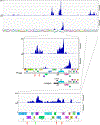Mycobacteriophage ZoeJ: A broad host-range close relative of mycobacteriophage TM4
- PMID: 30948168
- PMCID: PMC6452893
- DOI: 10.1016/j.tube.2019.01.002
Mycobacteriophage ZoeJ: A broad host-range close relative of mycobacteriophage TM4
Abstract
A collection of over 1600 sequenced bacteriophages isolated on a single host strain, Mycobacterium smegmatis mc2155, can be grouped into over two dozen types that have little or no nucleotide sequence similarity to each other. One group, Cluster K, can be divided into several subclusters, and the well-characterized and much exploited phage TM4 lies in Subcluster K2. Many of the Cluster K phages have broad host ranges and infect both fast- and slow-growing mycobacterial strains. Here we describe phage ZoeJ, a new Subcluster K2 member, which infects a broad spectrum of mycobacterial hosts including M. smegmatis, Mycobacterium tuberculosis, and Mycobacterium avium. ZoeJ has extensive sequence similarity to TM4, and comparative analysis reveals the precise deletion conferring the lytic phenotype of TM4. The ZoeJ immunity repressor was identified as gene 45, which is prophage-expressed, is required for lysogeny, and is sufficient to confer superinfection immunity to ZoeJ. ZoeJ gp45 also confers immunity to Subcluster K2 phage Milly, and Subcluster K1 phages Adephagia and CrimD, but surprisingly not to TM4. RNAseq analysis reveals the temporal pattern of early and late gene expressions in ZoeJ lytic growth and suggests a role for the ESAS motifs for gene regulation.
Copyright © 2019. Published by Elsevier Ltd.
Figures






References
-
- Jacobs-Sera D, Marinelli LJ, Bowman C, Broussard GW, Guerrero Bustamante C, Boyle MM, Petrova ZO, Dedrick RM, Pope WH, Science Education Alliance Phage Hunters Advancing G, Evolutionary Science Sea-Phages P, Modlin RL, Hendrix RW, Hatfull GF. On the nature of mycobacteriophage diversity and host preference. Virology 2012;434:187–201. doi: 10.1016/j.virol.2012.09.026 - DOI - PMC - PubMed
-
- Pope WH, Mavrich TN, Garlena RA, Guerrero-Bustamante CA, Jacobs-Sera D, Montgomery MT, Russell DA, Warner MH, Science Education Alliance-Phage Hunters Advancing G, Evolutionary S, Hatfull GF. Bacteriophages of Gordonia spp. Display a Spectrum of Diversity and Genetic Relationships. MBio 2017;8 doi: 10.1128/mBio.01069-17 - DOI - PMC - PubMed
Publication types
MeSH terms
Substances
Grants and funding
LinkOut - more resources
Full Text Sources
Other Literature Sources
Molecular Biology Databases

